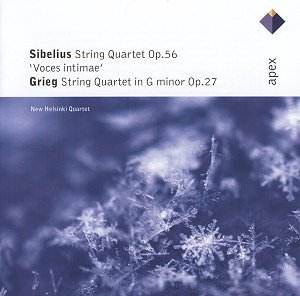The journey from full price to super-budget was a swift
one for this disc (originally on Finlandia 3984-21445-2). It was recorded
in September 1997 and it is to be hoped that it fares better as part
of the ‘Apex’ series, for these performances are confident and forthright.
The New Helsinki String Quartet present both pieces in the best possible
light: one comes away enriched from the experience. Their exemplary
tuning is a major contributory factor.
The Sibelius is placed first on the disc. It exhibits
a feeling of tightness of compositional thought (nowhere more so than
in the first of its five movements) and of great textural variety. The
second movement’s spectral opening is superbly brought off here and
the generally busy textures are very well performed.
The emotive heart of this piece lies with the 13-minute
Adagio di molto: here it is beautiful, flowing along so that it never
becomes turgid. The conviction of the entire performance is enough to
convince any doubters. The rustic grit of the fourth movement (marked
Allegretto ma pesante) is very involving; everywhere the spirit of Sibelian
ebb and flow is natural and free.
Grieg’s String Quartet, Op. 27 was written in 1877-8,
shortly after the first production of Peer Gynt. It became the
model for Debussy’s String Quartet of 1893: both share the same key
and both use a motto theme (Grieg uses a motif taken from his first
group of Ibsen settings, Op. 45). But the individual voices are different,
of course. For this account of the Grieg, both composer and the New
Helsinki Quartet are vigorous and confident in approach. Indeed, one
of the most fascinating aspects of this piece is the way it displays
the more experimental side of Grieg’s compositional persona (bringing
to mind the Slåtter for piano). There are some delightful
turns of phrase in the Romanze. The finale, marked Presto al
Saltarello, is basically a galop with a Scandinavian gait (although
here it could be played that bit more joyously). Nevertheless, this
remains a performance which impresses.
The Budapest Quartet on Biddulph (LAB098) adds Wolf’s
Italian Serenade to this coupling. Their Sibelius was recorded
in 1933, their Grieg in 1937 (although the latter was not issued until
1943) and they display a palpable sense of discovery. For a modern coupling,
though, the New Helsinki Quartet makes a strong case for these two pieces.
Colin Clarke


